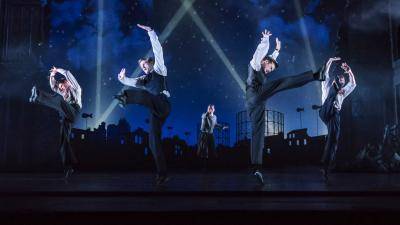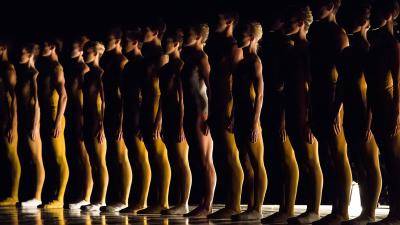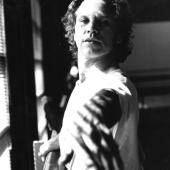Except for the biggest and best of the major dance companies, live orchestral music is something of an endangered species in the concert dance world these days. The Fusion program at the Carpenter Center (a collaboration between the CSULB Departments of Dance and Music) aimed to erase that unfortunate distinction with a program that featured CSULB faculty choreographers and a capable student orchestra conducted by Johannes Müller-Stosch in a program of classics and a few surprises. It was a program of serious themes and big music for the most part. The concert, cast with CSULB student dancers, was directed by Lorin Johnson and included a short film by Keith Johnson and Gregory R.R. Crosby. The program of five new works was costumed by Liz Pelster with lighting design and technical direction by Andrew N. Milhan.
Only two works in their entirety were included on the program, the Bach A minor Violin Concerto and Steve Reich's Three Movements. Excerpted works by Stravinsky, Mozart and Debussy completed the musical programming. It was a peculiar collection of music which often felt underplayed. Faring best in the performance category was Reich's Three Movements which was played with authority and rhythmic vitality. Both Stravinsky's Symphony in C (movements II and IV) and the two movements from Debussy's Images (Gigue and Rondes de Printemps) felt slight and muffled. Stravinsky's Tango was also included as part of Symphony in C but that excellent stand-alone music was drained of its quirky personality and dark rhythmic dance appeal mostly due to a ponderous tempo and lack of articulation. The Mozart Clarinet Concerto (Adagio), Piano Concerto 21( Andante) and Bach Violin Concerto were all given creditable journeyman performances by the orchestra and soloists Hiroshi Ikeda, Jiwon Eum and Esther Kang respectively.
Choreographer Sophie Monat offered an essay of pure dance with her Vista (Bach) for six women and three men. Hers was a safe approach to Bach which avoids complications with theme or personality in favor of ample rhythmic gesture, brief sections for changing groupings of dancers, and lots of coming and going. Monat moves her dancers around the stage well and keeps them spaced generously so we can see them in a way that reflects the clarity and precision of the music. You might find echoes of Concerto Barocco here, both in overall intent and even style. Monat was particularly good giving her women an air of confidence and expression with smart movement, but less so with the men, who looked tight and effortful, especially in the running transitions and jumps when exiting the stage. The sliding movements for the women (on pointe no less) were a welcome surprise and played well against the overall sense of Vista's evident sophistication. The three movements moved easily from one to the next. Partnering was minimal and mostly secure. One section went awry when the men failed to synchronize turns with their partners as they carried them, laid out horizontally. You could have wished for more vitality in the rolling 9/8 final movement and Vista's final moment lapsed into a generic rotating lift with one woman held aloft in a down pool of light. The mostly blue lighting (muted for the second movement) offered a basic scheme without overstatement or special effect. The women's dressy vivid blue leotards with a short skirt made them look leggy and slightly of the Balanchine mold . Costumes for the men, a dark, loose tank top and nondescript pants, were dull and didn't help brighten their diminished presence on stage. The cast of women for the Saturday matinee included: Courtney Boyd, Natalie Chadbourne, Amanda Kerby, Tamara McCarty, Bridgette McNulty and Emma Storey.

Elegy (What Rises Can Fall) choreographed by Lorin Johnson brings seven women together in Mozart's surrendering Adagio from the A Major Clarinet Concerto. Johnson has chosen music aptly for his theme of impermanence reflected in rising and falling motifs in both the music and movement. Particularly evocative was the recurring drop to a seated position followed by a backward slide. Elegy makes its mark with quiet, unspectacular movement. The groupings and unison sections at times felt cluttered. It was unclear what the intent of the swirling arm gestures of the opening had to do with his theme. They lacked the clarity and spare religiosity of the music itself. It takes a calculating sophistication to make movement of this nature believable and I felt that rather than navigating an ebb and flow, these dancers were often moving from pose to pose, missing out on a deeper intention. Stephanie Yonkovich gave Johnson's choreography an appeal and urgency absent in the other dancers. You could have wished for an ensemble who all danced to her inner rise and fall. Gauzy off white costumes helped give the dancers a floating, elegiac quality.
Night Flowers, choreographed by Colleen T. Dunagan suffered mightily on all fronts. It opened with a visually appealing tableau and later offered brief glimpses of dancing. It remained mostly a composition that immobilized eighteen women in a phalanx of dancers for two very long movements excerpted from Debussy's Images. There was only one short section in the final Ronde de Printemps where the dancers were allowed to set themselves free in a unison running spree which was effective and made you feel how much you had missed up to then. Dunagan bit hard for a very literal take on some symbolist poetics imagining a flower field, but was never able to set herself free from anything but an obvious reenactment. This involved a bit of reworking on Dungan's part since the original poetry (Verlaine) for Gigues references dancing and a lover's obsession. In the end, poetics and high concept are not enough to float a performance. You still have to dance and connect with the music and Night Flowers managed only briefly to escape its confining ideas.
Susan McLain's Life Line lived up to its high concept underpinnings. Here, the well played music (Three Movements by Reich) lent the choreography and dancing some authority. And while some of the program's choreographer's notes strayed into incomprehensible terrain, McLain clearly identified where her impulses lay. She says, Everyone needs a life line…this one is for my mother. McLain and dancers managed to assemble all the elements of lighting, costuming, movement and idea for the single standout performance of the concert. The work was visually stunning with hot white lighting from the wings, rich burgundy costumes, and a sense of space on stage. Stout ropes hang from the fly and come into play to both support and restrain the dancers. Tellingly, they are also used to help set them free. You could have wished for a more daring use of the ropes but in the end the whole piece is so satisfying to watch it matters little what might have been. The cast of nine dancers, both men and women, was appealing and athletic. Nothing felt over used and McLain made good use of the music's three sections with original and idiomatic movement referencing her background as a Graham dancer and at the same time overlaying it with the visual appeal of the theater dance idiom.
Diverting Normalcy, choreographed by Holly Johnston investigates the mundane. The dancers are subtly costumed in various patterned attire using grays and off whites. They gave her ensemble a cohesive look and a kind of everyman anonymity. Johnston's program note confuses more than it clarifies. She says she is discovering or at least looking for beauty in the ordinary. Whether that happens is up for grabs but the music (Stravinsky Symphony in C) is perhaps too heady and complex for this scenario and distractingly so. The piece uses movements II and IV with Tango (also Stravinsky) as a second movement. I mentioned earlier that the Tango interlude felt seriously underplayed. Here it sounded more like a toned down movement from the symphony than a tough and strident dance-themed composition. Johnston used a red lighting to set this section apart. She moves her dancers around well and the dancing has a thoughtful, quiet appeal. For me the reservoir of beauty in the ordinary remained more of a glimmer than a reality. And perhaps that's the kind of open ended possibility Johnston is after.
Humor and double meaning were everywhere apparent in the Johnson/Crosby film collaboration, Life In Security. It may be the only chance you ever get to laugh out loud during a live performance of a Mozart piano concerto. The music is played (silent movie style) to a split screen scenario of Johnson dancing secretly in his driveway. Dogs and stray cats make appearances along with Johnson suited up in various pajama getups. The message is (I guess) you never know who is watching or even why they might want to; but some day you might wake up to find your neighbor has invaded your surveillance operation with dance. Johnson never looks at the camera effectively giving you the sense that this is the real deal. In a sense he is spoofing our private moments which sometimes may be imbued with more emotion and secret intention than we care to admit. Our apologies to soloist Jiwon Eum who did what had to be done at the piano, supplying the sublime music in the face of multiple indignities. It's a tough business playing Mozart for laughs.
Fusion represents a real accomplishment and CSULB should be proud of the fact that they have a reservoir of artists capable of getting a big program like this to fly. I talked with two of the orchestra players following the concert about their experiences. One of them, a pianist/composer liked the idea of trying a concert of new music written by CSULB students for a subsequent dance and music collaboration. I hope that happens. It could be the beginning of a beautiful relationship.
(Saturday November 20, 2010 at The Carpenter Performing Arts Center, CSU Long Beach Department of Dance and Bob Cole Conservatory of Music)




